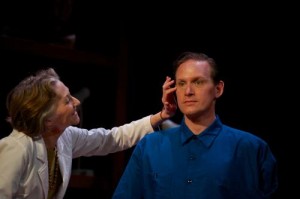Is There an I in Robot?: UNCANNY VALLEY at CATF
Theater Reviews Page | Previous Theater Review | Next Theater Review
Is There an I in Robot?: UNCANNY VALLEY at CATF
Posted on BroadwayWorld.com July 15, 2014
Mathematician and cryptanalyst Alan Turing famously posited, in the middle of the 20th Century, that if, in conversing with a machine, one cannot tell whether one is dealing with a machine or a human, artificial intelligence (AI) has been achieved. By the second decade of this century, AI is probably more of a party trick than a real presence (we don’t particularly mind having our computers and robots look and act like computers and robots), but Turing’s Test has long been passed, in a variety of ways. We are on to next steps: Thomas Gibbons’ new play Uncanny Valley explores what those steps are, and the philosophical, moral, and existential questions they pose.
When the play starts, sometime 30 or 40 years hence, we see a neck and head mounted on a desktop, the first module of a new, lifelike robot. Its fabricator and trainer, Claire (Barbara Kingsley), a scientist near the end of her career, wakes it up and starts it on its first lessons. The head, named Julian (Alex Podulke), blinks its eyes, and turns. Through a series of short blackouts it begins to acquire a voice, then knowledge, then conversational skills. After that, Julian acquires an arm, and learns to shake hands. And then, raising his hand to his hair, he says something crucial: “I perceive myself touching. I perceive myself being touched.”
Those two sentences exemplify the core of what some modern scientists and philosophers think consciousness is really all about: the integration of various sensations and perceptions at such high speed and such volume that either the illusion or the reality of a single personality perceiving itself is created. Most of us believe ourselves to be “real,” i.e. something more than the interchange of firing neurons. But if we are wrong about that, then, excluding the perhaps irrelevant fact that we are built from biological raw materials, we may all be as much robots as is Julian. Or, on the other hand, if we are right, could it nonetheless be true that at a certain level of mechanical activity and complexity, Julian may be as human as we?
The play is presented without intermission, but nonetheless there are two definite acts. The first comes to a point when Julian, now equipped with a full set of arms and legs, is told something that had been held back before: he was “purpose-built,” created with a certain body and face and certain capacities, for a particular role. And he (and we) learn(s) that once he is further customized, he will be irrevocably changed. By now he and Claire have what can only be called a friendship, so the first act ends on a valedictory note. He won’t be him (whatever that means, exactly) when it’s all over.
I shall not be giving away the role Julian is now called upon to play, except to say that it involves him functioning so that he would pass the Turing Test if he were attempting any deception. As such, he calls to fruition one of the most astonishing acting jobs I’ve ever seen. Alex Podulke, who did an impressive turn at CATF last season as suicidal actor, progresses by tiny gradations over the course of an hour and a half from impersonating a machine in speech and movement to a near-human in those regards, and one finds oneself saying, Of course that’s how a machine trying to imitate a human would look, even though one has never seen it before. Doubtless Tom Dugdale’s direction also has a lot to do with this extraordinary effect.
The coda to the play is fully earned, when Claire, forced to watch her aged husband’s journey in the opposite direction, into dementia, turns, apparently with hopefulness, to discover a gleam in Julian’s eye, “gazing back,” as he puts it, across the valley that separates cyber-life from biology.
Uncanny Valley is the whole package, everything you want a new play to be but seldom see: unique, thought-provoking, designed to evoke extraordinary performances, and filled with the unexpected.
Copyright (c) Jack L. B. Gohn, except for production photo
Theater Reviews Page | Previous Theater Review | Next Theater Review
